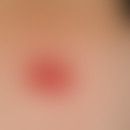DefinitionThis section has been translated automatically.
Retinol ( vitamin A) is a fat-soluble vitamin which can only be transported in the blood plasma when it is bound to specific proteins. These binding proteins are called retinol-binding proteins, RBP for short.
General informationThis section has been translated automatically.
There are four such specific binding proteins, which belong to the group of cytoplasmic lipid-binding proteins:
- CRBP I (from cellular retinol-binding protein)
- CRBP II
- CRABP I (from cellular retinoic acid binding protein)
- CRABP II
LiteratureThis section has been translated automatically.
- Blomhoff R et al (1994) Transport and metabolism of vitamin A. Nutr Rev 52: 13-23
- Napoli J et al (1996) Biochemical pathways of retinoid transport, metabolism and signal transduction. Clin Immun Immunopath 80: 52-62



